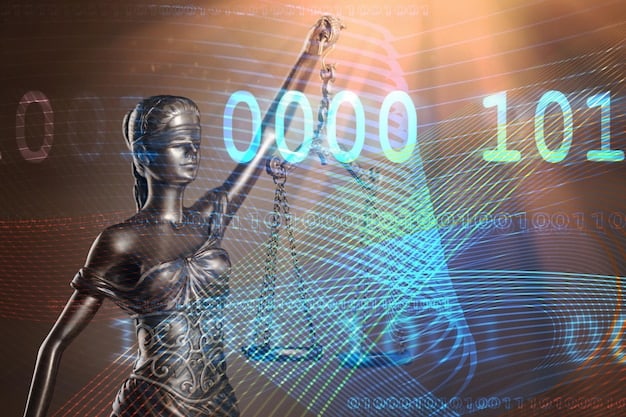AI in Criminal Justice: Can Algorithms Reduce Sentencing Bias?

AI and the criminal justice system is being explored for its potential to reduce bias in sentencing by analyzing vast datasets to identify and mitigate discriminatory patterns, yet concerns remain about transparency and perpetuating existing inequalities.
The intersection of AI and the criminal justice system: can algorithms reduce bias in sentencing? is a rapidly evolving field, promising to revolutionize how justice is administered. However, it also raises critical questions about fairness, transparency, and accountability. Can algorithms truly reduce bias in sentencing, or do they risk perpetuating existing inequalities?
The Promise of AI in Sentencing
The use of artificial intelligence (AI) in the criminal justice system is gaining traction as a potential tool to enhance efficiency and fairness. One area where AI is being actively explored is in sentencing, where algorithms can analyze vast datasets to identify patterns and predict recidivism rates. This approach aims to reduce human bias and ensure more consistent and equitable outcomes.
The promise of AI in sentencing lies in its ability to process large amounts of data without being influenced by emotions, prejudices, or extraneous factors that can affect human decision-making. By analyzing data on past cases, AI algorithms can identify factors that correlate with recidivism and use these insights to inform sentencing decisions. This data-driven approach has the potential to reduce disparities and improve public safety.
How AI Algorithms Work in Sentencing
AI algorithms used in sentencing typically involve machine learning models that analyze historical data on past cases, including factors such as the severity of the crime, the defendant’s criminal history, and demographic information. These models learn to identify patterns and correlations between these factors and recidivism rates. The goal is to predict the likelihood that a defendant will re-offend if given a particular sentence.
The algorithms can be trained using various machine learning techniques, such as regression analysis, decision trees, and neural networks. Once trained, the algorithm can generate risk scores that are used to inform sentencing decisions. These risk scores are intended to provide judges with additional information to help them make more informed and consistent decisions.
- Data Analysis: AI algorithms analyze vast datasets to identify patterns and correlations between various factors and recidivism rates.
- Risk Assessment: These algorithms then generate risk scores that estimate the likelihood of a defendant re-offending.
- Informed Decisions: Judges can use these risk scores to inform their sentencing decisions, aiming for more consistent and equitable outcomes.
- Bias Reduction: By relying on data rather than human judgment alone, AI seeks to minimize the impact of personal biases in sentencing.
In conclusion, AI algorithms offer a data-driven approach to sentencing that has the potential to enhance fairness and efficiency. By analyzing large datasets and generating risk scores, these algorithms provide judges with valuable information to help inform their decisions. However, it is essential to address potential biases in the data and ensure transparency and accountability in the use of AI in sentencing.
Potential Biases in AI Sentencing
Despite the promise of AI in reducing bias in sentencing, there are significant concerns about potential biases embedded within the algorithms themselves. These biases can arise from various sources, including biased training data, flawed algorithms, and the perpetuation of existing societal inequalities. Understanding and mitigating these biases is crucial to ensure fairness and equity in the application of AI in criminal justice.
One of the primary sources of bias in AI sentencing is the data used to train the algorithms. If the historical data reflects existing biases in the criminal justice system, the algorithm will inevitably learn and perpetuate these biases. For example, if certain demographic groups are disproportionately arrested and convicted, the algorithm may incorrectly associate these characteristics with a higher risk of recidivism.

Sources of Bias in Training Data
The data used to train AI algorithms is often collected from historical records of arrests, convictions, and sentencing decisions. These records may reflect existing biases in policing, prosecution, and judicial practices. For example, studies have shown that certain demographic groups are more likely to be stopped and searched by police, leading to a higher rate of arrests and convictions. This biased data can then be used to train AI algorithms, resulting in outcomes that perpetuate these inequalities.
Another source of bias is the way in which data is collected and labeled. If data is incomplete or inaccurate, it can lead to skewed results. For example, if data on socioeconomic factors is not included in the training data, the algorithm may incorrectly associate certain demographic characteristics with a higher risk of recidivism.
- Historical Data: The training data often reflects existing biases in policing, prosecution, and judicial practices.
- Data Collection: Incomplete or inaccurate data can lead to skewed results, perpetuating inequalities.
- Labeling Issues: The way data is labeled can introduce biases if certain factors are overemphasized or overlooked.
- Socioeconomic Factors: Failure to include socioeconomic factors can lead to algorithms incorrectly associating demographic characteristics with higher risk.
In conclusion, addressing potential biases in AI sentencing requires careful attention to the sources of bias in training data. By ensuring that data is accurate, complete, and free from bias, it is possible to develop algorithms that promote fairness and equity in criminal justice.
Transparency and Explainability
Transparency and explainability are critical components of ensuring the responsible use of AI in sentencing. Transparency refers to the extent to which the workings of an AI algorithm are open and understandable. Explainability refers to the ability to explain why an AI algorithm made a particular decision. Both transparency and explainability are essential for building trust and ensuring accountability in the use of AI in criminal justice.
One of the challenges of AI algorithms is that they can be complex and opaque, making it difficult to understand how they arrive at their decisions. This lack of transparency can undermine trust and make it difficult to identify and correct errors or biases. Therefore, it is essential to develop methods for making AI algorithms more transparent and explainable.
The Importance of Understanding AI Decisions
Understanding how AI algorithms make decisions is crucial for ensuring fairness and accountability. If judges, lawyers, and defendants cannot understand why an algorithm made a particular recommendation, it is difficult to assess its validity and challenge its accuracy. Transparency and explainability are also essential for identifying and correcting biases in AI algorithms.
One approach to improving transparency and explainability is to use simpler algorithms that are easier to understand. Another approach is to develop techniques for explaining the decisions of more complex algorithms. For example, some researchers are working on methods for identifying the factors that had the greatest influence on an algorithm’s decision.
- Fairness and Accountability: Understanding AI decisions is crucial for ensuring fairness and holding algorithms accountable.
- Algorithm Complexity: Simpler algorithms can enhance transparency, while techniques are needed to explain the decisions of complex algorithms.
- Identifying Key Factors: Methods are being developed to identify the factors that most influence an algorithm’s decision.
- Building Trust: Transparency and explainability are essential for building trust in the use of AI in criminal justice.
In conclusion, transparency and explainability are essential for ensuring the responsible use of AI in sentencing. By making AI algorithms more open and understandable, it is possible to build trust and ensure accountability in the application of AI in criminal justice.
Ethical Considerations
The use of AI in sentencing raises a number of ethical considerations that must be addressed to ensure that AI is used in a responsible and ethical manner. These considerations include issues such as bias, fairness, transparency, accountability, and the potential for discrimination. Addressing these ethical concerns is essential for building public trust and ensuring that AI is used to promote justice and equity.
One of the primary ethical concerns is the potential for AI algorithms to perpetuate existing biases in the criminal justice system. As discussed earlier, if the training data reflects existing biases, the algorithm will inevitably learn and perpetuate these biases. This can lead to discriminatory outcomes that disproportionately affect certain demographic groups.
Addressing Ethical Concerns in AI Sentencing
Addressing ethical concerns in AI sentencing requires a multi-faceted approach that involves careful attention to data, algorithms, and oversight mechanisms. It is essential to ensure that the data used to train AI algorithms is accurate, complete, and free from bias. This may involve collecting new data or correcting existing data to remove biases.
It is also important to develop algorithms that are transparent and explainable. This will allow judges, lawyers, and defendants to understand how the algorithm arrived at its decision and to challenge its accuracy. Additionally, it is essential to establish oversight mechanisms to monitor the use of AI in sentencing and to ensure that it is being used in a fair and ethical manner.

- Data Accuracy and Completeness: Ensuring data is accurate and free from bias is crucial for ethical AI sentencing.
- Algorithm Transparency and Explainability: Algorithms should be transparent, allowing for understanding and challenge of decisions.
- Oversight Mechanisms: Establishing oversight mechanisms is essential for monitoring the use of AI in sentencing.
- Promoting Justice and Equity: Addressing ethical concerns helps build public trust and ensures AI promotes justice.
In conclusion, the use of AI in sentencing raises a number of ethical considerations that must be addressed to ensure that AI is used in a responsible and ethical manner. By paying careful attention to data, algorithms, and oversight mechanisms, it is possible to develop and use AI in a way that promotes justice and equity.
The Role of Human Oversight
While AI has the potential to enhance fairness and efficiency in sentencing, it is essential to recognize that AI should not replace human judgment entirely. Human oversight is critical for ensuring that AI is used in a responsible and ethical manner. Judges, lawyers, and other legal professionals must play an active role in reviewing and evaluating the recommendations made by AI algorithms.
One of the reasons that human oversight is so important is that AI algorithms are not perfect. They can make mistakes, and they can be biased. Human judgment is needed to identify and correct these errors and biases. Additionally, human judgment is needed to consider the unique circumstances of each case and to make decisions that are fair and just.
Balancing AI Recommendations with Human Judgment
Balancing AI recommendations with human judgment requires a thoughtful and deliberate approach. Judges should use AI recommendations as one source of information among many, but they should not rely on them blindly. They should carefully review the data and the algorithm’s reasoning to ensure that it is accurate and appropriate for the case at hand.
Lawyers also have an important role to play in providing human oversight. They should carefully review the AI recommendations and challenge them if they believe that they are inaccurate or biased. They should also advocate for their clients and ensure that their rights are protected.
- AI is Imperfect: Human judgment is needed to identify and correct errors and biases in AI algorithms.
- Unique Circumstances: Human judgment is essential for considering the unique circumstances of each case.
- Balancing Act: Judges should use AI recommendations as one source of information, not blindly relying on them.
- Advocacy: Lawyers should review AI recommendations, challenging inaccuracies and protecting client rights.
In conclusion, the role of human oversight is critical for ensuring that AI is used in a responsible and ethical manner in sentencing. By balancing AI recommendations with human judgment, it is possible to harness the benefits of AI while safeguarding fairness and justice.
Future Developments and Challenges
The field of AI and criminal justice is rapidly evolving, with new developments and challenges emerging all the time. As AI technology continues to advance, it is essential to anticipate and address these challenges to ensure that AI is used in a way that promotes justice and equity. Some of the key future developments and challenges include improving data quality, enhancing algorithm transparency, and addressing ethical concerns.
One of the primary challenges is improving the quality and completeness of the data used to train AI algorithms. As discussed earlier, biased or incomplete data can lead to discriminatory outcomes. Therefore, it is essential to invest in data collection and cleaning efforts to ensure that AI algorithms are trained on high-quality data.
Anticipating Future Trends in AI and Justice
Anticipating future trends in AI and justice requires a proactive and forward-thinking approach. Researchers, policymakers, and legal professionals must work together to identify and address potential challenges before they become major problems. This may involve developing new methods for detecting and correcting biases in AI algorithms, establishing ethical guidelines for the use of AI in criminal justice, and promoting transparency and accountability in AI systems.
Another key trend is the increasing use of AI in other areas of the criminal justice system, such as policing and parole. As AI becomes more prevalent, it is essential to ensure that it is used in a consistent and ethical manner across all areas of the system.
- Data Quality: Improving data quality and completeness is crucial for fair AI outcomes.
- Algorithm Transparency: Enhancing algorithm transparency helps build trust and accountability.
- Ethical Guidelines: Establishing ethical guidelines is essential for responsible AI use.
- Broader Application: Ensuring consistent and ethical AI use across the criminal justice system is vital.
Ultimately, the future of AI and criminal justice will depend on our ability to address these challenges and to use AI in a way that promotes justice, equity, and public safety. By working together and embracing a forward-thinking approach, it is possible to harness the power of AI to create a more fair and just criminal justice system.
| Key Point | Brief Description |
|---|---|
| 🤖 AI in Sentencing | AI algorithms analyze data to inform sentencing decisions, aiming to reduce bias. |
| ⚠️ Potential Biases | Biased training data can lead to AI perpetuating existing inequalities. |
| ✍️ Transparency | Transparency and explainability are crucial for building trust in AI sentencing. |
| ⚖️ Human Oversight | Human judgment is essential to balance AI recommendations and ensure fairness. |
Faq
▼
AI has the potential to reduce bias, but it cannot eliminate it entirely, as algorithms are trained on data that may reflect existing societal biases. Ongoing monitoring and adjustments are necessary.
▼
Ethical concerns include the perpetuation of biased outcomes, lack of transparency in AI decision-making, and the potential for disproportionately affecting certain demographic groups. Fairness and accountability are key.
▼
Transparency can be improved by using simpler algorithms, explaining the factors that influence the AI’s decisions, and making the data and methodology open for review by experts and the public.
▼
Human judgment should serve as a critical oversight, ensuring AI recommendations are fair, accurate, and appropriate for the specific case. Judges should not rely solely on AI but consider all factors.
▼
Future developments include more sophisticated algorithms, improved data quality, enhanced transparency measures, and broader application of AI across different areas of the criminal justice system. Staying informed is key.
Conclusion
In conclusion, while AI and the Criminal Justice System: Can Algorithms Reduce Bias in Sentencing? presents a promising avenue for enhancing fairness and efficiency, it is essential to address potential biases and ethical concerns through transparency, human oversight, and continuous monitoring. Only then can we ensure that AI serves as a tool for justice rather than perpetuating existing inequalities.





